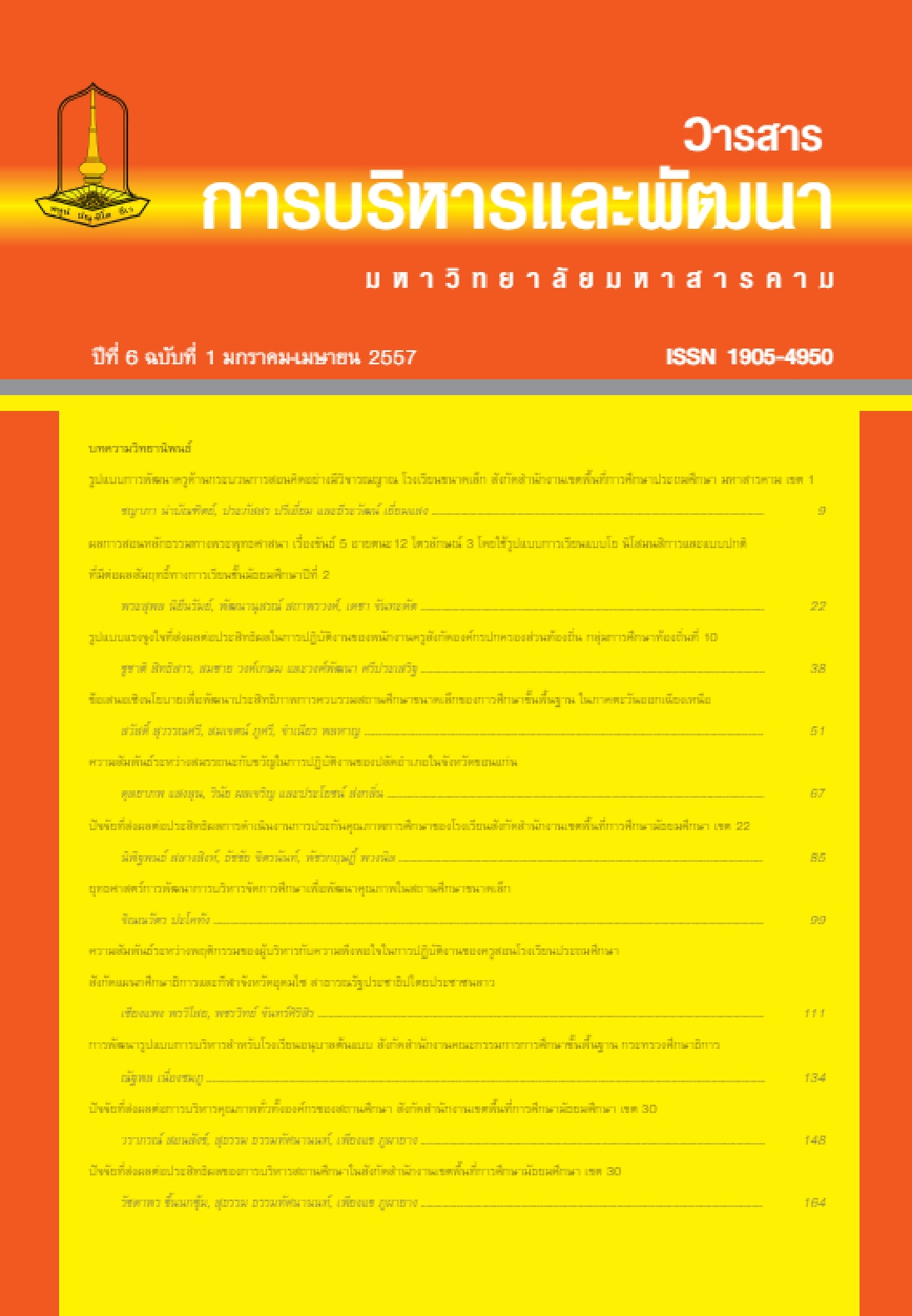The Development Strategies Improving the Quality of Education in Small Schools
Main Article Content
Abstract
The purposes of this research were 1) to investigate background information of the strategies, 2) to construct the strategies, 3) Trial development strategy and 4) to evaluate the constructed strategies for improving quality of education in small schools. The research instruments included documentary analysis, a survey questionnaire, interview, document instructed for a focus-group,and a focus-group record form. The statistics used in quantitative data analysis were mean and standard deviation and content analysis and categorization in qualitative data analysis.
The research findings were as follows:1. For the strategy background information, the development of educational quality was overall practiced at a high level. The result of the effective strategies for small schools included: 1) organizational structure building and 2) internal quality assurance performance. From the results of the in-depth interviews, two components with eight strategies were found: 1) Basic strategies including developments in organization and administrative structure, teacher capability, curriculum and learning procedure, information technological, and internal quality assurance system for preparation of external quality assurance examination and 2) Supporting strategies covering empowering teamwork, creating participation of all stakeholders in the community, and building networks.
2. Eight components were derived from the strategy construction: 1) preparing students, readiness and development, 2) systemizing educational quality supporting systems, 3) developing personal, 4) developing educational information technology, 5) developing curriculum and learning procedures, 6) promoting participation of all sectors in community, 7) raising resources, and 8) network building
3. Experimental results using strategic management development to improve the quality of education in small schools. The results showed that Development strategy to improve the quality of management education. In a small study, overall effectiveness is at the highest level. Through the evaluation criteria set forth. In the most
4. The evaluation of the constructed strategies indicated the highest level of all aspects of the suitability and feasibility. Through the evaluation criteria set forth. In the most.
Downloads
Article Details
References
คณะกรรมการการประถมศึกษาแห่งชาติ, สำนักงาน. ผู้บริหารสถานศึกษาต้นแบบ 2544.กรุงเทพฯ: วี.ที.ซี.คอมมิวนิเกชั่น, 2545.
คณะกรรมการการศึกษาแห่งชาติ, สำนักงาน. ระบบการประเมินคุณภาพและมาตรฐานการศึกษาแห่งชาติ. กรุงเทพฯ: พิมพ์ดี, 2549.
ธีระ รุญเจริญ. ความเป็นมืออาชีพในการจัดและการบริหารการศึกษาในยุคปฏิรูปการศึกษา.กรุงเทพฯ: ข้าวฟ่างจำกัด, 2550.
พวงรัตน์ เกสรแพทย์. การวางแผนกลยุทธ์สำหรับจัดการศึกษา. กรุงเทพฯ: สุวีรยาสาสน์,2543.
พักตร์ผจง วัฒนสินธุ์ และพสุ เดชะรินทร์. การจัดการเชิงกลยุทธ์และนโยบายธุรกิจ. พิมพ์ครั้งที่ 2. กรุงเทพฯ: จุฬาลงกรณ์มหาวิทยาลัย, 2542.
พิธาน พื้นทอง. ข้อเสนอเชิงนโยบายเพื่อพัฒนาศักยภาพของโรงเรียนขนาดเล็กในภาคตะวันออกเฉียงเหนือ. วิทยานิพนธ์ปริญญาดุษฎีบัณฑิต สาขาการบริหารการศึกษา บัณฑิตวิทยาลัย มหาวิทยาลัยขอนแก่น, 2548.
รังสรรค์ มณีเล็ก. การวางแผนเชิงกลยุทธ์ในสถานศึกษา. พิมพ์ครั้งที่ 2. กรุงเทพฯ: พล1996, 2545.
เลขาธิการสภาการศึกษา, สำ นักงาน. ยุทธศาสตร์การพัฒนาคุณภาพการศึกษา: ระเบียบวาระแห่งชาติ (พ.ศ. 2551-2555). กรุงเทพฯ: พริกหวานกราฟฟิค, 2551.
Bovee, Courtland and others. Management. New York: McGraw-Hill, 1993.


